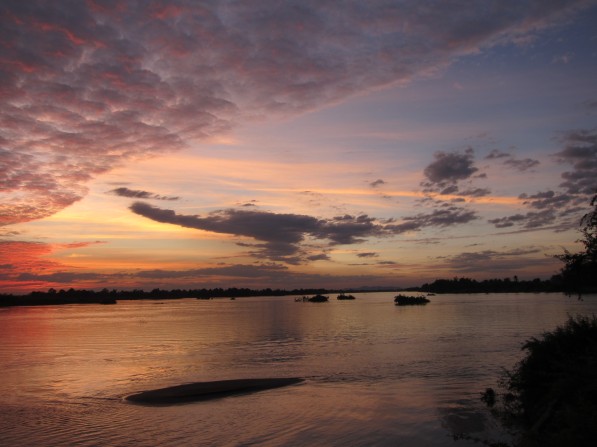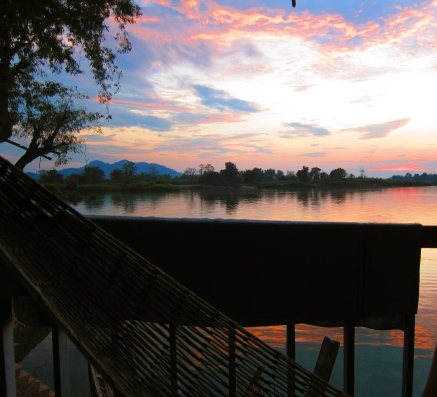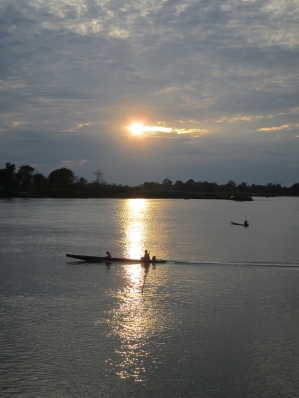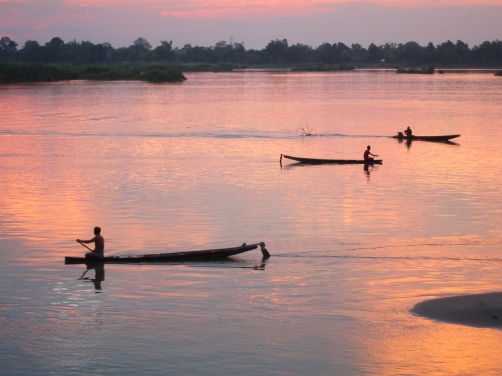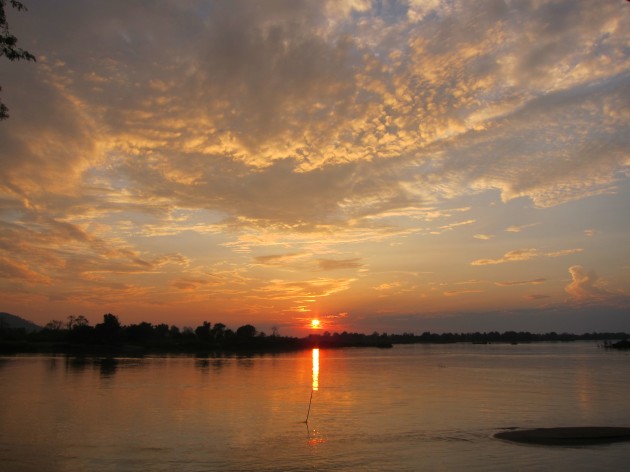
 Prologue
Prologue
Before we left on this trip, we said there were certain things we would never do, and renting a motorbike was definitely high on that list. How irresponsible would that be? I don’t even know how to talk to people who do that. And yet, we did. For those of you who know us well, you know how we can talk in sweeping absolutes and then one day, suddenly and inexplicably, change camps. This was one of those times. Our motorbike trip – or to use the local lingo, ‘motobike’ trip – was such a crowning achievement for us as travelers, as partners, and as human beings that I don’t begin to remember why I thought this was a bad idea in the first place. I mean, of course I do, and I think it has something to do with dead-in-a-ditch-somewhere, but we’re not, so it’s all okay. And people who don’t rent ‘motobikes’? I don’t even know how to talk to those people.
(Sorry, Mom and Dad.)
Things to Know about The Loop
How long is it? The Loop is a 450km loop leaving from Tha Khaek. You should give yourself four days and three nights.
Which way should I go? It is best done counterclockwise – or as the Brits call it, anticlockwise.
Where should I rent my bike? Only one right answer: Mr. Ku’s. He keeps his bikes tuned well for the roads and he is responsible for this stellar map of The Loop which will be indispensable on your travels. Better yet, he instills confidence in even the most beginnerest of beginner motobike riders. Also, he is available by cell any time of day to give you advice should anything go awry. He’s basically your mom.
Wait, I still have lots of questions?! First of all, get over yourself. Best thing to do is to show up in Tha Khaek, crash at the Thakhek Travel Lodge, and thumb your way through something called ‘The Log’ which is a big scrapbook of people’s recommendations and experiences doing The Loop. It’s super helpful and also funny. You will find yourself conveniently located next door to Mr. Ku’s rental office. Perfecto!
Getting Started + Learning to Ride
And we did just that. We made our way to the Travel Lodge, stowed our bags in their storage room, flipped through ‘The Log’ until we felt confident enough without feeling confused, and before we lost our nerve, we tucked in next door and asked to see Mr. Ku. Only he wasn’t there. You see, Mr. Ku doesn’t just wait around for folks like us. There is a grown-ass man whose sole job it is to sit in a folding chair outside Mr. Ku’s office and call him on his cell phone when people are looking to rent a bike. Seriously. That’s his only job. 15 minutes later, the Big Ku rolls up: cool, confident, and ready to rent us Lucky Number Eight. He walks us through the rental agreement and then whips out his map. I love watching people do things they’ve done a thousand times before. All those little red marks on the map? Those are his annotations that he writes in as he gives us his spiel, confirming things we’d already deduced, like which was the right way to go around, and how many days to spend, but also giving us pitch-perfect information on things like when to leave each day, where to spend the night, how long various legs would take, and when we’d lose the light in the afternoon as we drove through various valleys.
Then came the bike lesson. Now, I’ve never even ridden on the back of a motobike, never mind actually driving one. And moreover, I don’t know how to drive a manual transmission. It was clear to me that I would not be the one receiving the lesson from Mr. Ku. Too much was at stake. And so The Hubs stepped up and got the lesson, which included learning how to turn it on, learning how to shift the gears and how to brake, and then learning where Mr. Ku’s phone number was printed on the front of the bike. Smooth as ice, Mr. Ku drove down the driveway and back with The Hubs clinging onto the rear. Then, herky jerkily, The Hubs drove himself down the driveway and back. Aaaaaaand… lesson complete. We suited up with our little day packs and our helmets (we always wore our helmets) and set off into traffic. And let me tell you, The Hubs was awesome. He was amazing. It was so impressive watching him tackle this new thing and learn it, getting better by the kilometer, the gear shifts getting smoother. And I didn’t flinch! Or at least not verbally, too much, and thankfully he couldn’t see my face in the side view mirror.
Once we were underway, we dipped onto a quieter side road and The Hubs taught me to drive a motobike. I learned how to drive a motobike! He was patient and encouraging and never once condescending. We were doing this because we could do this and we were doing it together. That meant we were both going to be drivers and we were both going to be passengers. It was all like one big trust fall. Cheesy, yes, but that’s honestly how it felt. We had to trust each other to do this successfully.




 Freedoms of the Open Road
Freedoms of the Open Road
Getting out onto the open road was so freeing! Need a bathroom break? Pull over whenever you want. Hungry? We brought some snacks. Need lunch? Oh, that might get a bit more interesting. How do you figure out what’s a restaurant when you’re suddenly not in a touristy area and nothing’s in English? The answer is somewhere between trial and error and testing out your charade skills. After a few stops, we found a place that was willing to sell us a plate of something, and with the help of a phrase book, we managed to communicate that we would like something with chicken. The rest was up to them. Thankfully, we knew the drill for a truly local joint: always use the outdoor sink to wash up before and after your meal. And after a few hours on a motobike, you better believe I was ready to wash the dust off just about every bit of exposed skin.
At some point that first afternoon, the pavement ran out, and I dutifully handed over the handle-bars. I could drive a motobike, sure, but it wasn’t clear how sharp my learning curve would be with new road material. And so The Hubs had yet another opportunity to shine that day. What a guy, truly. This is one of those times you could most decidedly argue that video games helped develop necessary life skills. The road conditions were crap. It was mostly packed gravel, but the potholes were so frequent at times that it wasn’t clear where one was supposed to drive. Since we never made it much above about 15mph, we had a good response time when a pothole snuck up on us, and it allowed us to take in the glory of our surroundings, too.
The last bit of driving that day was a stark contrast: on one side lush jungle, and on the other massive deforestation and flooding caused by a new dam. Hundreds of people were displaced by the flooding, and we found ourselves driving by newly-built ‘healthy villages’ which had a deserted and eerily-crisp feel to them. And yet the newly created lake was breathtaking, and we struggled with the odd conundrum that water is always beautiful, even when it’s for environmentally questionable reasons.
Petanque + Bad Road + Shock Repair
That first night, our spirits ran high, elated with the day’s success. As we pulled into our guesthouse, we spotted the petanque court right away, and it wasn’t long before we were out there for a game. The staff at this place was super friendly and included a crew of local men who seemed to be renting out a few of the bungalows on more of a longterm loan sort of arrangement. They took a keen interest in our game, heckling The Hubs when he started to lose, and pouring me small glasses of beer to help improve my throws. By the time we’d finished, we’d been taken into the fold, and were invited to join them for beers and home made bar snacks of banana chips and roasted pumpkin seeds. Despite a significant language barrier, their hospitality and overwhelmingly generous natures shined through.
The next morning, we set off early for what we knew would be another challenging bit of road. What we thought had been crap conditions the day before seemed like fresh asphalt in comparison to what we faced this morning. As many potholes but with much bigger rocks and gravel filling in the road, and curvier, and more hills. Up, down, around, it didn’t seem to get any better, and then… we lost the ability to drive straight. It’s true. Our intense and awesome road trip had cracked one of our front shocks, and Lucky Number Eight’s front wheel was now coming out from the handlebars at an unhealthy angle.

 What happened next felt like it was out of an indie movie. The mechanic’s shop is part general store and part family home. The mother is out front pounding her laundry while children run around playing. Her eldest son – probably somewhere near our age – wheels our bike in and has the whole front section taken apart in a few quick minutes. We watch in awe over the next twenty as he busies himself tightening and re-tightening things, putting it all back together but better. We were wrong – the bike’s not really broken – we’d just loosened things riding on all that rough road. The kindest moment in all of Laos is as he’s handing it off to us, steadily refusing payment for his time. It’s only after The Hubs presses him that he accepts a meager square of chocolate as thanks.
What happened next felt like it was out of an indie movie. The mechanic’s shop is part general store and part family home. The mother is out front pounding her laundry while children run around playing. Her eldest son – probably somewhere near our age – wheels our bike in and has the whole front section taken apart in a few quick minutes. We watch in awe over the next twenty as he busies himself tightening and re-tightening things, putting it all back together but better. We were wrong – the bike’s not really broken – we’d just loosened things riding on all that rough road. The kindest moment in all of Laos is as he’s handing it off to us, steadily refusing payment for his time. It’s only after The Hubs presses him that he accepts a meager square of chocolate as thanks.
And yet… Five feet out the door, we realize Lucky Number Eight is still crooked. Turns out we know more about motobikes than we thought. The shock is cracked. Irreparably. (Is it ever reparable?) And the next hour is spent sitting in the dust as our new friend replaces it. A whopping $20 is all it costs. But this was all still part of the trust fall, right? We were succeeding in connecting with the locals – through thick and thin, no less. That’s what this trip had become.
Konglor Cave

 This is no ordinary cave. Our last day on the road included a detour to get to this 7.5 km long limestone tunnel formed by the Nam Hinboun river. Although it was a generally less bat-swooping experience than I had hoped, riding through this tunnel was incredible. It’s completely dark inside, and each boat requires two boatmen: one to steer and one to help push or pull the boat through low water points. The one steering wore a huge headlamp that flicked back and forth to various reflector points guiding the way. It felt like we were going about a million miles an hour and was quite reminiscent of the tunnel scene from Willy Wonka & the Chocolate Factory. Except, you know, a lot less creepy.
This is no ordinary cave. Our last day on the road included a detour to get to this 7.5 km long limestone tunnel formed by the Nam Hinboun river. Although it was a generally less bat-swooping experience than I had hoped, riding through this tunnel was incredible. It’s completely dark inside, and each boat requires two boatmen: one to steer and one to help push or pull the boat through low water points. The one steering wore a huge headlamp that flicked back and forth to various reflector points guiding the way. It felt like we were going about a million miles an hour and was quite reminiscent of the tunnel scene from Willy Wonka & the Chocolate Factory. Except, you know, a lot less creepy.
More Pictures…
There were so many good shots from the road, so I’m throwing a few more of my favorites in here.








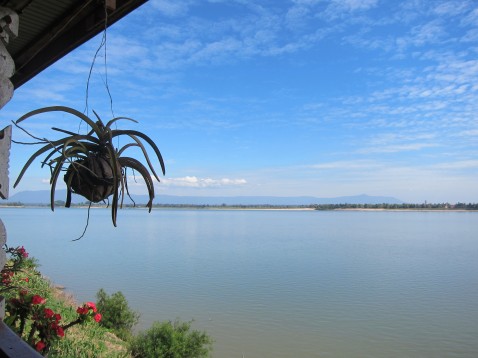
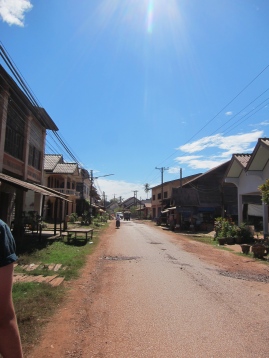 Champasak & Wat Phu
Champasak & Wat Phu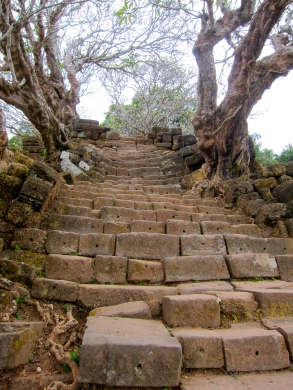
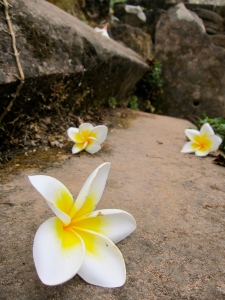 Champasak sees most of its tourist draw from the ruins at Wat Phu, an ancient Khmer religious complex which stretches 1,400m up the Phu Pasak mountain range. The name translates to ‘temple-mountain’ and it definitely feels like that. The steps alone are gigantic, making you feel as if you’re climbing to another realm; and indeed, the notion is that it should be difficult for a mortal to reach the gods. We didn’t find the structures to be quite as compelling as the site itself, with its mysterious airs and the ever-changing perspective as you climb, not to mention the sweeping views of the surrounding area once you reach the summit. The site is dotted with countless flowering frangipani trees, the Lao national flower, and swept us up in the swelling emotion of national pride for a country we had truly come to love.
Champasak sees most of its tourist draw from the ruins at Wat Phu, an ancient Khmer religious complex which stretches 1,400m up the Phu Pasak mountain range. The name translates to ‘temple-mountain’ and it definitely feels like that. The steps alone are gigantic, making you feel as if you’re climbing to another realm; and indeed, the notion is that it should be difficult for a mortal to reach the gods. We didn’t find the structures to be quite as compelling as the site itself, with its mysterious airs and the ever-changing perspective as you climb, not to mention the sweeping views of the surrounding area once you reach the summit. The site is dotted with countless flowering frangipani trees, the Lao national flower, and swept us up in the swelling emotion of national pride for a country we had truly come to love.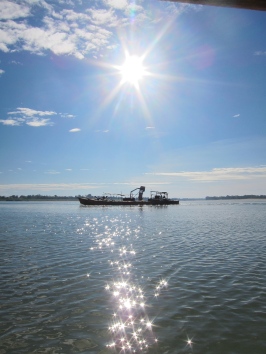
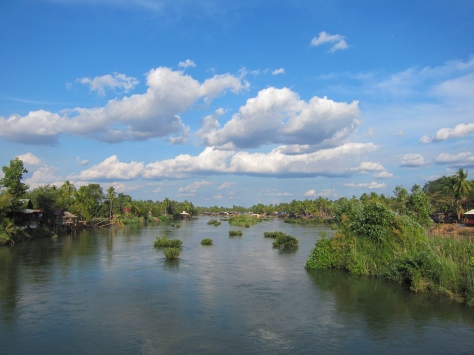 Si Phan Don is at the southernmost tip of Laos, right near the border with Cambodia, and is also know by its translation: ‘four thousand islands’. The Mekong spans even wider down here with islands big and small dotting the water like a splatter paint picture. We arrived by boat again, choosing to stay on Don Det (map here), one of two islands equipped with tourist accommodations. There are so many accommodations, in fact, that it’s a bit overwhelming figuring out which is the right one for you. But despite the mid-day heat, we stumbled our way into a private duplex bungalow on the sunset side of the island for $5/night. It was a sweet spot and one we called home for a full week; our longest stay yet in any one place!
Si Phan Don is at the southernmost tip of Laos, right near the border with Cambodia, and is also know by its translation: ‘four thousand islands’. The Mekong spans even wider down here with islands big and small dotting the water like a splatter paint picture. We arrived by boat again, choosing to stay on Don Det (map here), one of two islands equipped with tourist accommodations. There are so many accommodations, in fact, that it’s a bit overwhelming figuring out which is the right one for you. But despite the mid-day heat, we stumbled our way into a private duplex bungalow on the sunset side of the island for $5/night. It was a sweet spot and one we called home for a full week; our longest stay yet in any one place!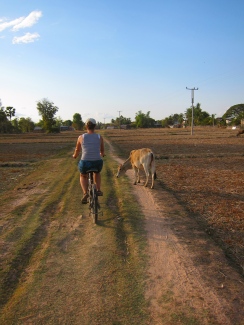
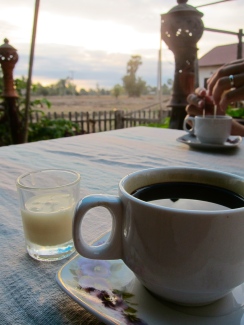
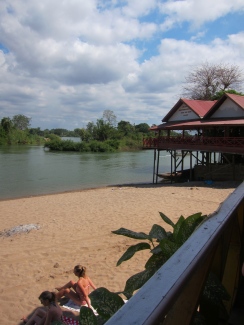 This final week in Laos was like one long swan song. We sat on the beach, we rode bikes, we read, we watched the sunset. But it also presented new challenges to us as travelers, like when I came down with a nasty bout of food poisoning, and then The Hubs followed suit just a few nights later. There was something primitive about the whole experience, and not just because the plumbing in Laos never exactly instilled confidence. It stripped away all the distractions of our travel, forcing us to focus on our immediate needs and meet them. It made us rest finally! But the loveliest part – if I can say that about a double-header of food poisoning – was that it brought us closer together. Over the less-than-pleasant 72-hour period, we danced this symbiotic dance between patient and caregiver, and I couldn’t help feeling incredibly grateful in the face of all that vulnerability. We celebrated 10 years together on Don Det, just about the same time time we were both eating solid foods again – a cause for twice the celebration – and a wonderful way to end our six weeks in Laos.
This final week in Laos was like one long swan song. We sat on the beach, we rode bikes, we read, we watched the sunset. But it also presented new challenges to us as travelers, like when I came down with a nasty bout of food poisoning, and then The Hubs followed suit just a few nights later. There was something primitive about the whole experience, and not just because the plumbing in Laos never exactly instilled confidence. It stripped away all the distractions of our travel, forcing us to focus on our immediate needs and meet them. It made us rest finally! But the loveliest part – if I can say that about a double-header of food poisoning – was that it brought us closer together. Over the less-than-pleasant 72-hour period, we danced this symbiotic dance between patient and caregiver, and I couldn’t help feeling incredibly grateful in the face of all that vulnerability. We celebrated 10 years together on Don Det, just about the same time time we were both eating solid foods again – a cause for twice the celebration – and a wonderful way to end our six weeks in Laos.